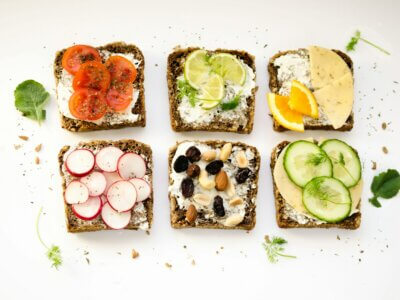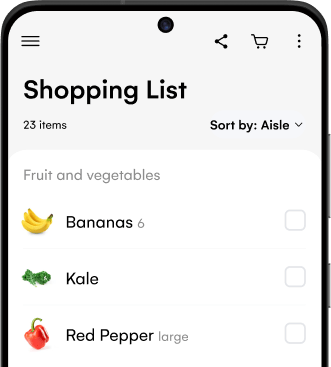Estimated reading time: 6 minutes
Eating more can help you lose weight. It might sound too good to be true, but it is possible. Sometimes restricting calories can leave you feeling hungry because you may not be eating enough high satiety foods or getting enough volume from your food. That’s where low calorie foods come in.
Analyse nutritional information for any recipe

The feeling of fullness after eating a meal or a snack is called satiety. Satiety helps with appetite control. In turn, the type of food you eat might help control your appetite for the next meal, snack or even day. Focusing on high volume and high satiety foods that are packed with nutrition, low in calories, and fill you up is key to getting as much satisfaction out of your daily calories as you can.
Losing weight by creating a calorie deficit
Consuming less calories than your body needs puts your body in a calorie deficit. Calories provide energy and come from carbohydrates, protein, and fat. Carbs and protein each provide 4 calories per gram and fat has 9 calories per gram.
There are many low calorie foods that you can eat and still reach your weight loss goal while staying in a calorie deficit. Low density foods have a higher water content which increases the volume without increasing calories. Good examples are most fruits and vegetables, which you can eat a whole bowl of without putting much of a dent in your overall calorie consumption.
High density foods are high in calories – fat and sugar tend to pump up the calories, so your favorite ice cream or pizza is probably quite high in calories. Note that not all high calorie foods are ‘unhealthy’ options though. Avocado, nuts, seeds, and full fat yogurt are all healthy foods packed with nutrients and benefits but are higher in calories. Though that’s not a problem, it does mean you can eat less of them than low calorie and high volume foods if you want to stay in a deficit.

Guidelines for low calorie foods
In the USA, packaged food must follow the FDA’s guidelines to market the food as low calorie and calorie free on their labels. Low calorie foods cannot contain more than 40 calories per two tablespoons serving and calorie free cannot have more than 5 calories per serving. There are a lot of low calorie snacks on the market, some products have added fiber and protein to promote satiety. Of course, this will vary depending on where you live. But rest assured that knowing the basics of whole foods and learning how to read nutrition labels will help you identify foods which are low volume and high calorie versus those which are high volume and low calorie.
Not all low calorie foods are created equal. Snacks and meals made from whole food ingredients will have the most naturally occurring fiber and protein without added ingredients like their packaged counterparts.
There are low calorie foods that have a similar amount of calories, but the impact on satiety may be different. For example: you could have a third of an avocado for around 80 calories and 1 gram of protein. Or, you could have two stalks of celery with two tablespoons of hummus, which equates to around 82 calories, 2.5 grams of protein, and 3 grams of fiber. Celery with hummus provides much more volume despite having the same amount of calories, and may curb your hunger for longer. It also has the benefit of having added protein.
Create your own recipes from scratch

Foods that make you feel full
There are so many different types of food that can help you feel full. Foods that contain protein and fiber have the biggest impact on satiety, offering a large volume for less calories, which may help you reach your goal without feeling hungry all the time.
Most foods that naturally contain protein don’t contain fiber, but it is beneficial to pair them together. Protein is important because when it breaks down into amino acids in the body it releases hormones that help with satiety.
The way food is prepared is another thing to consider when trying to reduce your caloric intake. For example, eggs can be hard boiled or poached in water instead of scrambled or fried eggs. Though the eggs themselves are the same, the added oil and butter can increase calories quickly.
The nutrition facts labels are helpful when you’re counting calories and looking for foods rich in both protein and fiber. Samsung Food app provides detailed nutritional information for ingredients and is a great tool for low calorie meal planning. Not only do all of the recipes have the calories, protein, and fiber information available but you can even see an overall health score and substitute ingredients to see how your changes impact the nutrition.
Here are some examples of foods which can increase satiety without you consuming too many calories.
Vegetables
1 cup yields anywhere from 7 to 50 calories
- Leafy greens (lettuce, kale, spinach, arugula)
- Carrots (slices)
- Celery
- Peppers
- Zucchini
- Cucumbers
- Mushrooms
- Cruciferous vegetables (broccoli, cauliflower)

Fruit
A medium serving of fruit yields anywhere from 50-100 calories and up to 8 grams of fiber
Protein
The calorie range for the specified serving ranges from 70-200 calories and 5-26 grams of protein
- Eggs (1 large)
- Chicken, lean beef, turkey (4oz)
- Shrimp, salmon, and tuna (3oz)
- Black Beans (½ cup)
- Edamame, tofu, tempeh (½ cup)
- Raw or dry roasted nuts (1oz)
- Dairy (lower fat versions have less calories)
Whole grains
Cooked ½ cup servings yield 70-125 calories and around 2-4 grams of protein and 1.5-3 grams of fiber
- Quinoa
- Brown Rice
- Pasta
- Oatmeal
How to add more low calorie foods to your meals
Fruits and veggies add volume and fiber to meals and snacks without adding many calories. These low calorie foods can fill you up through their high water content and high volumes, especially when paired with protein.
Easy ways to add veggies include salads, stir fry, roasted veg, using lettuce or cabbage instead of wraps, spaghetti squash or zucchini noodles in place of pasta. You can boost flavor with veggies like fennel, fresh herbs, radishes, onions, and garlic. Mixing in about a tablespoon of chia seeds to yogurt, cottage cheese, and smoothies provide extra nutrition in the form of fiber and protein without adding many calories.
Eating low density but high satiety foods may make your body feel full without all of the excess calories. On the other hand, eating a low calorie diet containing mostly processed foods may not provide the feeling of fullness after they are eaten and lead to overeating.
It’s important to carefully plan balanced meals and snacks incorporating fruits and veggies, lean protein, and carbs to get the most out of your eating plan. As always, consult with your healthcare provider before making dietary changes.
And if you’re not sure where to begin with making small changes for your health, know that Samsung Food allows you to search for low calorie recipe inspiration and add them to your meal planner with one tap.



